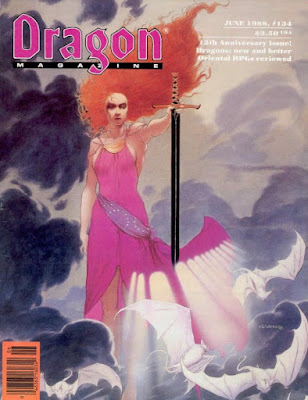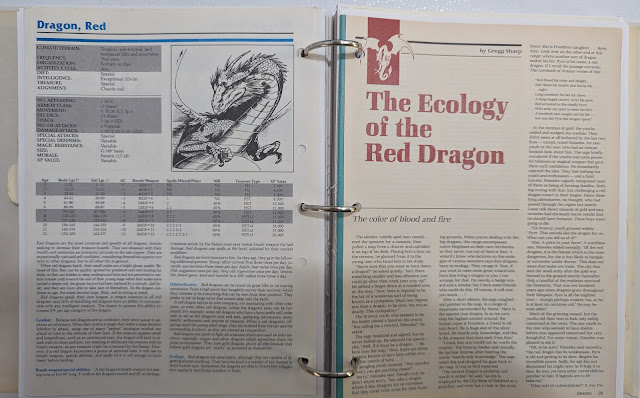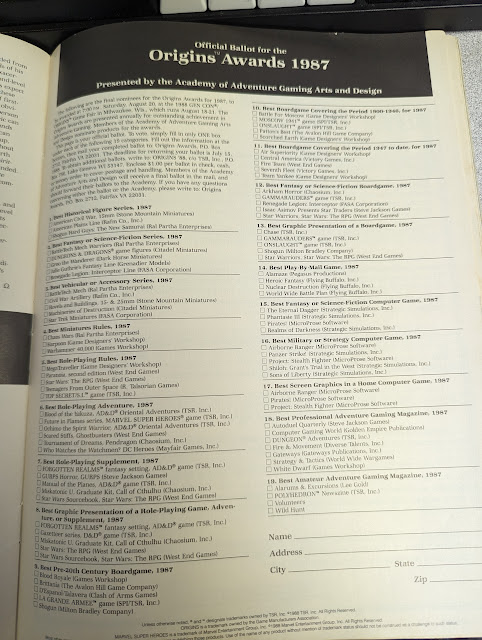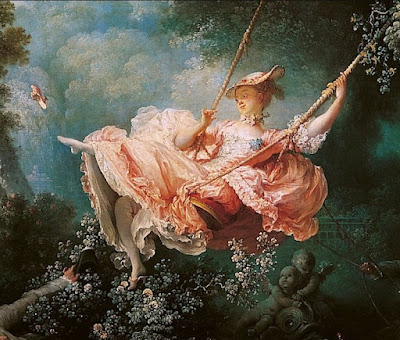 |
| via Hasbro |
I have talked about my experiences, I have shared a lot of characters I have used over the years, talked about all sorts of D&D games. I have spent time talking about the Forgotten Realms, Ravenloft, and, as always, Mystara. While I personally feel like I could have done a lot more I am confident in one thing,
I did a lot more talking about D&D 50th anniversary than Wizards of the Coast.
Yes. There was the giant "The Making of Original Dungeons & Dragons" book which seemed to please and piss people off in equal measure. There were some 50th Anniversary minis, and yes, the new edition of D&D, which they missed the mark on by having the Monster Manual out in 2025. But in truth, there has been...very little.
Look, I don't like to spend time here on things I don't like. Sure, I could rage about this game or that and bitch and moan and complain. But honestly, we have enough people that do that on blogs and on YouTube, and it is fucking boring. I don't give a fuck about the shit you hate. Tell me about what you love. Get excited. Geek out over a game or a new dice mechanic or something. But I honestly don't care what you think of "those kids today." It makes you sound old and irrelevant.
But I can't let this year pass and not mention how badly the ball was dropped here.
Wizards has not been having a great couple of years. From the OGL fiasco to sending hired goons after Magic players to massive layoffs and declining quality of their adventures, it would be all too easy to pick on them. I am only going to focus on couple of things though.
50 Years Should Mean Something
Ok. So we had the "The Making of Original Dungeons & Dragons" book which was cool and some minis. But what else?
I mentioned the minis. There was also the Quests from the Infinite Staircase which had some great classic adventures updated to D&D 5. But it wasn't released with as much fanfare as I would have suspected.
There was quite a bit of fanfare for the 10th Anniversary, same for when Wizards did the 25th Silver Anniversary Edition. Was I anticipating more? Yeah, I certainly was. Was I wrongfully anticipating more? That I don't know.
How about a comparison.
The 10th Anniversary set included: D&D Basic Rules (Player's Guide and DM's Guide, BECMI), D&D Expert Rules (Expert Rulebook, BECMI), D&D Companion Rules (Player's Guide and DM's Guide, BECMI), D&D Character Record Sheets (1981, BX), MSOLO1 Blizzard Pass (with 2 pens), B1 In Search of the Unknown (Fourth print), B2 Keep on the Borderlands (Fourth print), X1 Isle of Dread (Fifth print), AC2 Combat Shield and Mini-Adventure, AC3 Kidnapping of Princess Arelina, and six dice and a dice crayon. All in a faux-leather slipcase with gold lettering. Essentially, it is an homage and celebration of the Basic-era rules.
The 25th Anniversary set included: Facsimiles of the original modules featured in TSR’s Silver Anniversary releases: B2 Keep on the Borderlands, G1 Steading of the Hill Giant Chief, G2 The Glacial Rift of the Frost Giant Jarl, G3 Hall of the Fire Giant King, I6 Ravenloft, and S2 White Plume Mountain. A replica of the original Dungeons & Dragons rulebook. A 32-page book outlining the history of TSR - including a retrospective essay by Gary Gygax. L3 Deep Dwarven Delve - a recently recovered, never-before-released Original Edition adventure by Len Lakofka. A specially created, suitable for framing art print by Jeff Easley. All in a silver slip case. No dice, but a new never before published adventure.
The 50th has largely been represented by the new rules (5.5), The Making of Original Dungeons & Dragons, and Quests form the Infinite Staircase. Fun, but does it really fit the celebration bill? Are these books that will command collector's prices in 10 or 25 years? I am going to say no.
Where are the Baldur's Gate 3 Tie-ins?
Baldur's Gate 3 was the top-played game of 2023 and 2024. It won every single Game of the Year award and awards in general sci-fi and fiction, and many of the voice actors are now considered up-and-comers in terms of entertainment. It has won BAFTAs, Hugos, Nebulas, and GLAAD media awards. To downplay its success is either to be completely out of touch or willfully ignorant.
Yet. NOTHING for the game has come from Wizards of the Coast. No minis (they are coming out next year), no adventures or starter sets (there is one coming in the Fall 2025, but I can't determine if it has Baldur's Gate material). There are new Forgotten Realms books coming in late 2025. But all of this feels like too little too late.
Now. One could argue that Larian Studios, the creators of Baldur's Gate 3 only within the last few month gave Wizards back the license. But see it is a license. Wizards could have been doing tie-in stuff from August of 2023 when it became obvious that this game was going to be a mega-hit. Look what they did for Baldur's Gate 2 back in the late 1990s. They had Volo's Guide to Baldur's Gate out for the game. So much so that the books was actually titled "Volo's Guide to Baldur's Gate 2."
I talked about this before. They could have had an adventure or something out. "Love the video game? Continue your adventures here! Take your characters beyond 12th level in the table-top version!"
Spend any time on any Baldur's Gate discussion board, and two things are obvious. First, people LOVE these characters. Secondly, people want more with these characters.
While this is not necessarily 50th anniversary related, it is undoubtedly a fumble of epic proportions.
They do talk about Baldur's Gate 3 in their upcoming digital tabletop, but again, that is not out now. I am not looking for a huge expenditure of cost here, a one-shot with the characters at first level (Larian already made character sheets for that), or how about Monster Manual-like entries for people to download some of the monsters/NPCs in the game. Larian Studios spent more time and effort on freaking Wulbren Bongle than Wizards has on all the other characters combined.
What Would I Have Done?
To be honest, this is pretty loaded. I have only nostalgia to guide me and no budgetary concerns or stockholders to appease. That being said, I am sure I could come up with some better ideas.
First, Books and sets. The Making of Original Dungeons & Dragons book was a good one, but they should not have stopped there. I would have redoubled the efforts to get all the OD&D books on DriveThruRPG into Print on Demand and get them sold. Not everyone will shell out $100 for the making of OD&D, but many will shell out $20.00 or so for a new version of OD&D. They can even use the new "white" covers they all have. We know they have print ready files from the OD&D collector's set they published a while back.
Second, Constant celebration. Wizard should have gone to all the popular actual play streamers and had them run a classic adventure. Vox Machina going through The Tomb of Horrors, get the Baldurs Gate voice actors to go the Caves of Chaos. White Plume Mountain and Ilse of Dread. Make these place names something that the newer generations want to know about. And honestly while it would not matter if these were played in 5e or not, I would like to have seen some of these groups try AD&D 1st ed. I know Mercer could do it, that is where he started, so let's see some of these big streamers talk THAC0 for a session or two.
Third, Social Media involvement. Yes this means people acting for the company and thus paid, but it still should be done. It gets people talking about the brand AND maybe mends some fences broken by Wizard's recent less-than-stellar behavior. What would they do? How about D&D Trivia to win a copy of "Making of" or the giant art book they made. I am sure they have a few of those still lying around. OR send out goodie bags to smaller streamers and bloggers to make the case for them. Wizards should have had places where people could tell their stories of adventures of the last 50 years. Friends made, battles won, or lost and what D&D means. Normal people and the occasional celebrity as well. They should have sent people to Cons to record these and play them back on YouTube.
Fourth, Game Stores. Game Stores still are the heart of many RPGs. So send them material like organized play and host old-school D&D tournaments using AD&D tournament rules. Include prize support. Survive the Ghost Tower with the most points? Here is your special, not-for-retail-sale set of Ghost Tower dice. Provide Game Stores with special items to draw in customers.
Fifth, Reprints. I know. Reprints are expensive. Distribution is expensive. But I also know that gamers would have eaten it up. A copy of Ravenloft I6 with 50th Anniversary gold trim? Come on, I would have bought that in a heartbeat. Limited run to conserve cost, but make it a Game Store exclusive. Original content. Chose some of the best from all areas of D&D. Yes, Infinite Staircase kinda, sorta does this, but I am talking adventures and books just like the 10th and 25th Anniversary did.
Sixth, BALDUR'S F'ING GATE. Look, I can't stress enough how much of a missed opportunity this was. While the game is still riding high and will be for a while, each day that goes by is one more day of lost revenue. People have hundreds, even thousands of hours, in this game. They should be able to take their "Tavs" (and honestly, you should know who Tav is) and move them to the tabletop. And when they got there, Karlach, Astarion, Shadowheart, and Scratch should all be there waiting.
I am sure I could come up with more. But I am approaching bitching about level and that means a good place to stop.
The 50th should have been a reflection on what made D&D so great. Not a litany of missed opportunities or near misses.






.jpg)































